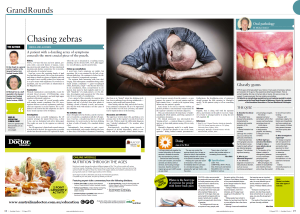 This article was published in Australian Doctor in the “Grand Rounds” segment. It was titled “Chasing zebras” in the print and online version.
This article was published in Australian Doctor in the “Grand Rounds” segment. It was titled “Chasing zebras” in the print and online version.
Authors: Alan Huynh and Michael Tam
This article is also available on the Australian Doctor website (registration required).
Case
Ivan, a 60-year-old man and new patient to the General Practice Unit at Fairfield Hospital, presented with a one-week history of insomnia, nausea and vomiting, anorexia, and weight loss. When probed, he had experienced insomnia and daytime somnolence over the past half-year, with episodes of nocturnal sweats.
Ivan had a poor diet, consisting of junk food and takeaway meals. He was a long-term smoker and claimed to drink two glasses of brandy with coke each night. Ivan was socially isolated, living alone and on poor terms with his neighbours. He worked as a machinist, and was previously an infantryman in the Bulgarian army. Physical examination was unremarkable, except for an elevated blood pressure (150/90), sinus tachycardia (100/min), and mild right upper quadrant tenderness.
Ivan had seen his usual GP several months earlier with similar somatic complaints. His GP had conducted investigations that did not reveal an explanatory pathology. Ivan came requesting a “second opinion” and was committed to the notion that his symptoms were due to heavy metal exposure in his workplace.
Concerned about a possible malignancy, the GP registrar arranged for urgent blood tests and a CT of the chest, abdomen and pelvis. Reassuringly, the results did not demonstrate anything alarming. The GP supervisor, whose clinical and research interest is in the field of alcohol, suggested that a possible alcohol use disorder needed to be explored in depth when the case was discussed in a teaching session, pointing out the elevated GGT, suggestive red cell indices, and elevated ferritin. On follow up, Ivan’s symptoms were milder but persisting. He was not reassured by the lack of pathology in his results. He continued to have a firm belief that his distress was related to occupational exposures.
The registrar found interacting with Ivan challenging. Each subsequent consultation brought a hodgepodge of additional somatic complaints – gastro-oesophageal reflux, flank pain, cough – that became a focus of the visit. In one memorable consultation when a sexual history was conducted, Ivan boasted that he regularly paid for sex and claimed “hundreds” of sexual partners over his lifetime. Investigation and assessment for sexually transmitted infections dominated the next couple of consultations.
Over a period of three months, the registrar provided counselling, education and support with regards to sleep hygiene, the safe use of alcohol (Ivan later admitted to drinking a bottle of brandy a week), and reassurance that his work with brass, bronze and cast iron would not be the cause of his symptoms.
The definitive visit
Ivan was brought in by his brother, and the true history was revealed. This consultation was coincidentally with the GP supervisor. There was a decades-long history of alcohol dependence. In the recent weeks, he had been drinking at least a bottle of brandy (20+ standard drinks) a day. Intermittently Ivan would attempt to quit, experience withdrawals, and resume drinking after 2 or 3 days. The brother was frustrated and remarked that Ivan was in “denial” about his drinking problem. Ivan was suffering from obvious withdrawals – tremors, tachycardia, and hyperreflexia.
After liaising with the onsite drug and alcohol service, Ivan was commenced on diazepam, to be supervised by his brother over the next 24 hours, and admitted for inpatient detox the following morning.
The supervisor reviewed Ivan’s file and found a very curious entry in the registrar’s records relating to the first visit. Written under differential diagnosis was “? alcohol withdrawal”! What had happened?
Discussion and reflection:
Retrospectively, everything pointed towards a diagnosis of alcohol dependence which was consistent with the registrar’s initial clinical impression. However, the anxiety from the context – a new patient, the request for a second opinion, and his high somatic focus – resulted in the registrar being drawn into the patient’s “hidden” agenda. Ivan’s desire to be seen as someone without an alcohol problem was unconsciously reciprocated by the registrar’s attention on alternate diagnoses.
This case demonstrates the importance of understanding the whole patient and being cognisant of consultation dynamics. The clinical assessment was side-tracked into chasing “zebras” – common things are common and 1 in 4 adult patients seeing GPs are risky drinkers. (1) Murtagh’s diagnostic model is a useful framework – alcohol use disorder is one of the “masquerades”. (2) Furthermore, the bewildering array of symptoms should prompt the fifth question in Murtagh’s model – “is this patient trying to tell me something else?” (2) Happily, Ivan did well with his inpatient detox, and remains on the path to recovery.
References
- Britt H, Miller GC, Henderson J, Bayram C, Harrison C, Valenti L, et al. General practice activity in Australia 2013–14. General practice serious no. 36. Sydney: Sydney University Press; 2014.
- Murtagh J. Murtagh’s general practice. 4th ed: London: McGraw-Hill; 2007.
